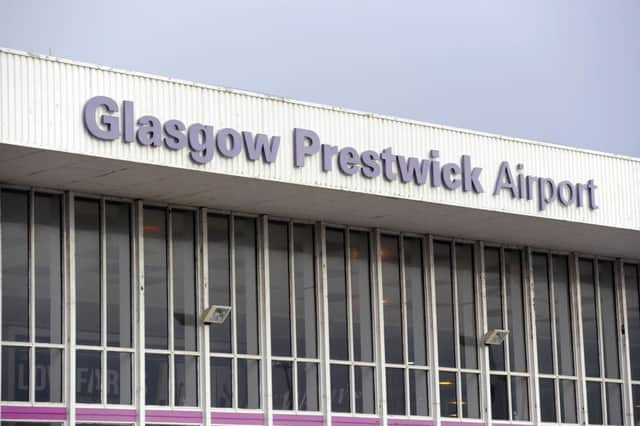David Brash: Things are on the up for Prestwick


As we leave the holiday season behind and get back to our busy lives, it is likely many people will see a return to regular air travel. We expect to see a continued growth in air traffic and new technologies will be deployed to ensure that safe and efficient operations are delivered.
Last December saw a major step for Prestwick in increasing airspace capacity, reducing carbon and cutting fuel burn with the introduction of a project called Reduced Lateral Separation (RLAT) where aircraft could be spaced closer together safely across the ocean along the North Atlantic Tracks they travel with, initially, the addition of one track.
Advertisement
Hide AdAdvertisement
Hide AdOnce fully implemented, the International Civil Aviation Organisation (ICAO) initiative, which NATS worked on jointly with NAV CANADA (the Canadian air navigation service provider), will save an estimated 52,000 tonnes of carbon a year, equivalent to the emissions of 14,000 transatlantic flights.
As technology and air traffic management has evolved it has become normal for air travel to be an easily accessible and affordable method of transport. But this has not always been the case.
During the Second World War a large number of aircraft were ferried from America to Britain. Initially the plan was to pack the aircraft in crates and transport them by sea. However Lord Beaverbrooke vigorously pursued the plan to fly the aircraft across the North Atlantic. To control this, the Trans Atlantic Air Control (TAC) was formed at Prestwick in 1941. The first location of TAC was at Air Defence HQ in Powbank Mill adjacent to Prestwick Airport. Later that year operations moved to Redbrae House, sited at Prestwick Airport in Ayrshire.
The method of Air Traffic Control (ATC) was basic - the position, altitude and track of each crossing aircraft was plotted on large map and communication with the aircraft was by Morse code.
It took the establishment of the ICAO to accelerate the development of commercial air travel across the North Atlantic.
ICAO came into being as a specialised agency of the United Nations in 1947 and originally created to promote the safe and efficient development of civil aviation. ICAO split the globe into regions with the North Atlantic being identified as one of the regions. Meetings were held to agree rules for flying in this airspace. Oceanic Area Control Centres (OACCs) were established at Prestwick, Shannon in Ireland, Moncton in Canada, New York, Iceland, Norway and Portugal providing ATC services in the North Atlantic. These countries still meet to coordinate developments in the North Atlantic today.
During the 1950s and 1960s the technology changed with Morse code being replaced by high frequency radio (voice communications). Although radar, a war time invention, was being used to help separate aircraft over land, this could not be used over the North Atlantic because there was nowhere for the radars to be located. As a result of this the distance the aircraft needed to be separated by was much larger than the standards applied when flying over land. This is still the case today. Aircraft are separated by 1,000ft vertically and 5 miles laterally over land. When flying over the Atlantic aircraft are separated by a minimum of 25 miles laterally 5 minutes flying time longitudinally and 1000ft vertically.
Traffic grew as aircraft technology improved, reducing costs and improving safety. Air transport overtook shipping as the main means of crossing between continental Europe and North America. A big technological step was realised in 1964 with the introduction of the Apollo computer to help cope with the increased volume of traffic.
Advertisement
Hide AdAdvertisement
Hide AdFrom the formation of the North Atlantic region until the mid-1960s, control centres at Prestwick and Shannon operated in the same airspace. At an ICAO meeting held in 1965 it was agreed that radio communications would be the responsibility of Shannon with Prestwick having the responsibility of Air Traffic Control and this is how things still operate today.
The early 1970s saw the OACC move from Redbrae House to Atlantic House in Prestwick. This would become the home for not only Oceanic Control but also the Scottish Area Control Centre (which controls flights over land in and out of Scotland). Although there have been technical upgrades to equipment and new purpose built operations rooms built, the method of operation was much the same as it had been throughout the 1970s.
Moving right up to the present, the Oceanic Area Control centre controls aircraft in approximately 700,000 square miles of airspace stretching towards Iceland to the north, Spain to the south and half way across the North Atlantic. The method of operations has been an ever-evolving journey that has seen traffic rise dramatically. In 1941, 805 flights were handled across the North Atlantic, whereas today Prestwick OACC handles approximately 450,000 flights per year. In 2015 Prestwick Oceanic Control had its busiest day ever where it handled 1,564 flights almost double that of 1941 total figure.
The development of Air Traffic Control is continually progressing. The next time you are journeying across the Atlantic remember the role that Prestwick and all the people who have worked in its centres have played and continue to play in providing a safe and efficient Air Traffic Service.
• David Brash, deputy general manager operations, Prestwick Centre